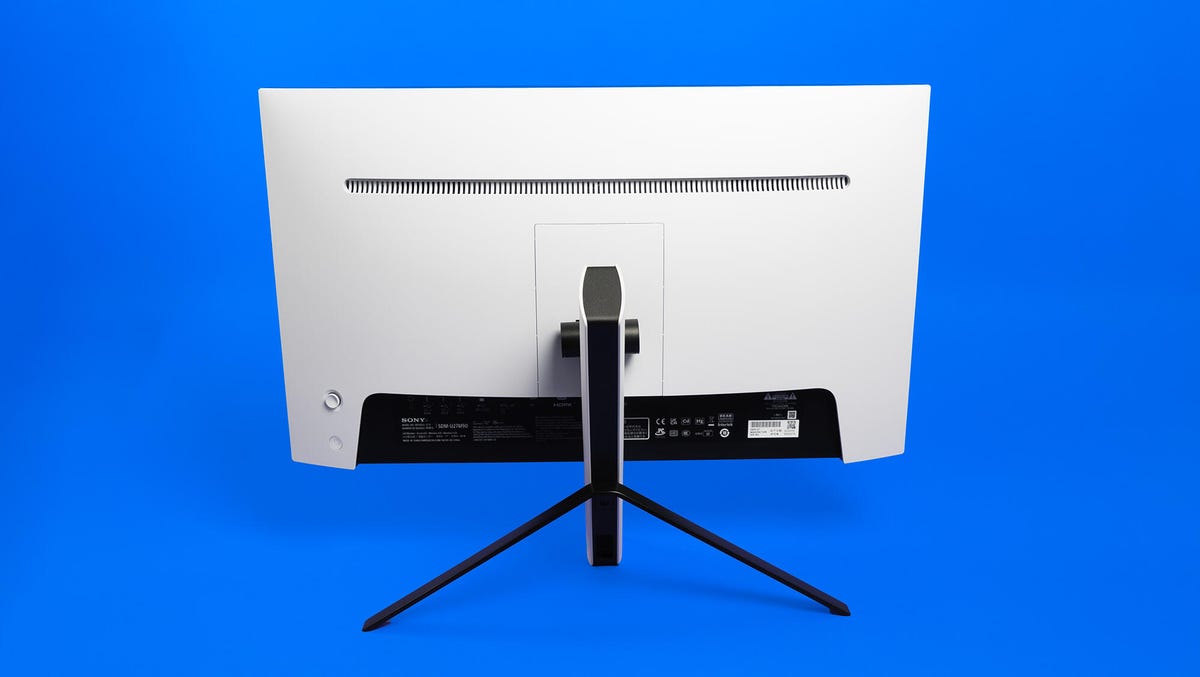Sony launches its first PC gaming monitor as part of its debut of the InZone line of PC and PS5 compatible accessories — and its first general-purpose monitor in decades. Sony primarily targets FPS fans with the 27-inch M9, which kind of does the monitor a disservice. With DisplayHDR 600 certification and a 96-zone local dimming array backlight, 4K resolution at up to 144Hz and HDMI 2.1 with VRR connectivity for consoles, it’s really suited to the bulk of gaming genres. Maybe not to all pocketbooks, though.
The InZone M9 (SDM-U27M90) is slated to ship this summer for $900 and will be followed by the M3 (SDM-F27M30) by the end of the year for $530. The M3 will have a 1080p 240Hz screen with a limited sRGB gamut and minimal HDR in the form of DisplayHDR 400.
Physically, the monitor uses similar materials as the PS5, albeit forgoing the PS5’s organic design in favor of a more angular aesthetic common to PC gaming displays. The rear legs of the stand don’t look substantial, though they seem to be. Though it might look different from the pack, ultimately the monitor’s setup and operation is the same as everyone else’s.
Sony InZone M9 (SDM-U27M90)
| Price | $900 |
|---|---|
| Size (diagonal) | 27 in./68.5cm |
| Panel and backlight | IPS with direct backlight, FALD |
| Flat or curved | Flat |
| Resolution and pixel density | 3,840 x 2,160, 163 ppi |
| Aspect ratio | 16:9 |
| Maximum gamut | 95% DCI-P3 |
| Brightness (nits, peak/typical) | n/a |
| HDR | DisplayHDR 600 |
| Adaptive sync | G-Sync Compatible |
| Max vertical refresh rate at 4K | 144Hz (DisplayPort, USB-C via DP alt mode), 120Hz (HDMI 2.1) |
| Gray/gray response time (milliseconds) | 1ms |
| Connections | 1 x DP 1.4, 2 x HDMI 2.1, 3 x USB-A (out), 1 x USB-B (in), 1 x USB-C (in or out) |
| Audio | Headphone jack, 2 x 2w speakers |
| VESA mountable | Yes, 100 x 100mm |
| Panel warranty | 1 year limited; at least 0.01% defective pixels to qualify for coverage |
| Release date | Summer 2022 |
The monitor is expensive but not outrageous for its features and performance. In addition to the dual HDMI 2.1 connections, it also supports USB-C for display. It’s got speakers, though they’re not sufficient for gaming.

It does have a striking profile.
Lori Grunin/CNET
I wish Sony had decided to break a little with tradition and use a better layout for the connections and cable management. Like many, the connections sit under a ridge on the rear, set back far enough that you’ve got to go through some contortions if you’re trying to plug something in blindly — which you’ll be doing, because that’s where the three USB-A connectors live. And one of the two HDMI 2.1 connectors is almost impossible to reach because it’s mostly blocked by the stand.
It has a tiny plastic hook that can hang off one of the thin legs through which you’re supposed to feed your cables. It’s not large enough to accommodate a few thick ones though, and really feels insubstantial.
The onscreen display annoyingly defaults to one of the least-needed menu entries — DDC on/off, and a level down — which makes navigating a chore if you have to do it a lot.

The connections are in the usual, inconvenient place.
Lori Grunin/CNET
It has a built-in KVM switch, which means the USB ports depend upon the active input. That’s a perk if you’re connecting to two different systems or a PC and a console. The input scanning looking for an active connection seems to take a little longer than normal, though, and I got some unexpected resets (where it decides to recheck its connection) — such as between benchmark tests — that I’ve never seen with other monitors.
The monitor does shine in many ways. Sony really, really expects you to stick to HDR. In a change from the norm, it’s calibrated in HDR, but not SDR, which is good if you plan to use that mode a lot. And oddly, the default SDR setting is with local dimming turned on and set to high. That’s not necessarily a bad thing, but may result in some unexpected behavior in places where you’re expecting uniform brightness and contrast. It also changes with the presets — high, low and off — along with brightness.
Accuracy isn’t bad in SDR, but it takes a little tweaking to get it within tolerances; dropping the green and blue channels to 95% did the trick as a quick-and-dirty solution.
Global measurements
| SDR | HDR | |
|---|---|---|
| Gamut | Approx. 93% P3 | 97% P3 |
| Contrast | FALD off 920:1, FALD high (max brightness) 42,000:1 | Approx. 77,000:1 (53,000:1 lower left to 82,000:1 middle right) |
| White point | Warm: 6,300K, neutral: 7,800K, cool: 8,800K | Approx. 6,500K |
It does work best in HDR, where it hits its maximum gamut and expected white point. The tone curve gets thrown a bit because it doesn’t seem to have the maximum brightness controlled well; I got readings as high as about 800 nits, but I think the system’s assuming it won’t hit that high.
I kind of miss having HDR presets to choose from, though. In Windows your choices are on or off. On the PS5, it supports Auto HDR and Auto Genre picture mode. The latter means that it changes to a game-optimized, low-latency mode when you launch a game and to a cinema-optimized mode when it detects a movie playing. Once again, though, all auto.
Color measurements (presets)
| White point | Gamma | Brightness at center (nits) | Accuracy (DE2K average/max) | |
|---|---|---|---|---|
| Cinema | 6,300K | 2.4 | 273 | n/a |
| FPS | 7,900K | 2.0 | 441 | n/a |
| Game 1 (default) | 7,700K | 2.3 | 444 (peak)/269 (typical) | 3.64/8.85 |
| Game 2 (custom, adjusted) | 6,680K | 2.2 | n/a | 1.67/3.96 |
| Standard | 6,300K | 2.2 | 228 | 2.48/3.76 |
| HDR | 6,500K | n/a | 791 | n/a |
The InZone M9 isn’t my favorite all-around monitor, but thanks to the HDR performance and VRR support, it’s still a top choice for dual-system gamers looking for a great picture and flexibility.
How we test monitors
All measurements are performed using Portrait Display’s Calman Ultimate 2021 R4 software using a Calibrite ColorChecker Display Plus (formerly X-Rite i1Display Pro Plus) and a Murideo Six-G pattern generator for HDR testing where necessary, or the Client3 HDR patterns within Calman, where possible. How extensive our testing is depends on the capabilities of the monitor, the screen and backlight technology used, and the judgment of the reviewer.
On the most basic models we may stick with just brightness, contrast and color gamut, while on more capable displays we may run tests of most user-selectable modes for gaming or color-critical usage, uniformity and so on. For the color work, we may also run tests to verify how white point accuracy varies with brightness.
Color accuracy results reported in units of Delta E 2000 are based on Calman’s standard Pantone patch set, plus the grayscale and skin tone patches. White points results are based on both the actual white value plus the correlated color temperature for the entire gray scale (21 patches, 0 to 100%) rounded down to the nearest 50K as long as there are no big variations. We also use Blur Busters‘ motion tests to judge motion artifacts (such as ghosting) or refresh rate-related problems that can affect gaming.




